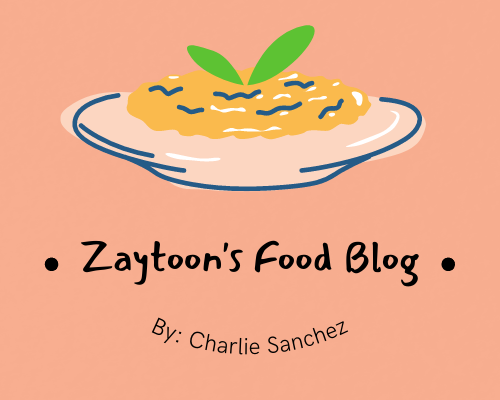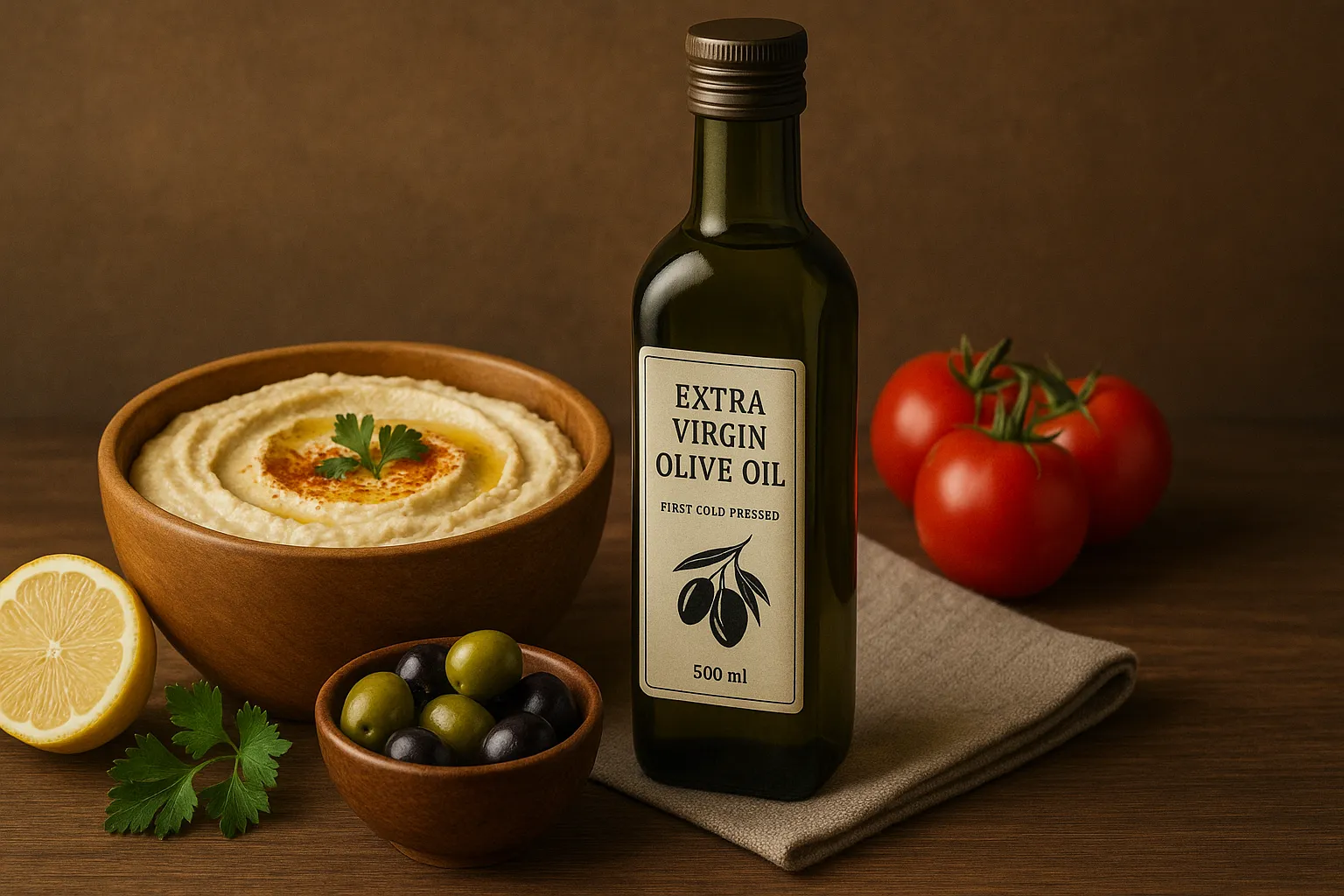Ever felt overwhelmed staring at a wall of olive oils at the store?
You’re not alone. Choosing the right olive oil can feel like guessing in a foreign language. “Extra virgin” sounds good, but is it always better? Can you use it for frying? Is the flavor that different from vegetable oil?
If these questions have crossed your mind, this guide is for you. We’ll walk through what makes olive oil a standout ingredient.
You’ll learn about its health benefits, how it transforms food, and why it has deep roots in Middle Eastern kitchens. By the end, you’ll know exactly how and why olive oil earns its place on your table.
A Legacy in Every Drizzle: Olive Oil’s Cultural Role in the Middle East
Did you know some Middle Eastern families have used the same olive tree groves for generations?
When olive oil hits the table in Middle Eastern homes, it’s not just about taste. That bottle carries stories, memories, and habits passed down for centuries.
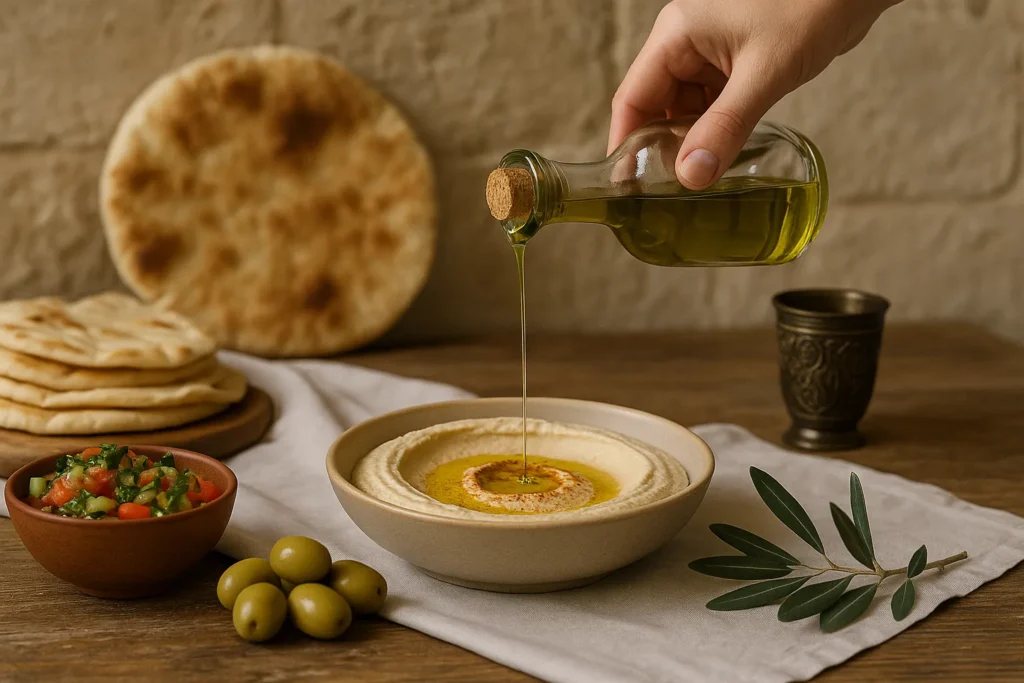
You’ll see it poured at breakfast, stirred into hearty lentil dishes, and used to finish meals with a signature touch.
In this region, olive oil means generosity and hospitality. It’s offered with warm bread (delicious!), infused with thyme or sumac, and often replaces butter in traditional recipes.
This deep-rooted presence reflects how closely tied olive oil is to everyday life, both in the kitchen and around the table.
Many families still take part in seasonal olive pressing. Children learn to taste a new batch, detect bitterness or spice, and store it properly for the months ahead.
These traditions aren’t about gourmet flair. They’re about knowing and trusting your ingredients.
That kind of closeness helps explain why people across the region prefer extra virgin olive oil for nearly every dish. But what actually makes this type different from other oils on the shelf?
That’s what we’re going to cover next.
What Is Extra Virgin Olive Oil, Really?
Extra virgin olive oil is the highest quality olive oil available. Unlike processed olive oils that are high in fat and calories, it’s made by cold-pressing fresh olives without heat or chemicals.
This gentle process helps preserve the natural flavor, antioxidants, and nutritional value. That makes it ideal for everyday cooking and recipes where taste matters.
To qualify as “extra virgin,” the oil must meet specific international standards. These include:
- Acidity below 0.8%. Lower acidity means the oil is fresher and less oxidised (source).
- No additives or chemical processing. It must contain only pure, cold-extracted olive juice.
- Full-bodied flavor. Depending on the olives used, it may taste grassy, slightly bitter, or peppery. That strong taste often signals high antioxidant content.
These traits separate extra virgin olive oil from other categories. Virgin olive oil also comes from the first press but may have slightly higher acidity or small flavor flaws.
Refined oils such as “pure” or “light” olive oil are heavily processed. They often lose their nutrients, colour, and distinct flavor during production.
But not all extra virgin oils are worth the money. Some are falsely marketed as being “pure” and the price is inflated.
Here’s how to identify a bottle that’s worth your money:
- Look for a harvest date and the phrase “cold-pressed” on the label.
- Choose dark glass or metal tins that block light and help prevent spoilage.
- Taste it. If you notice a little bitterness or a tingling sensation at the back of your throat, that usually points to higher levels of polyphenols, which benefit your health.
When you’re cooking meals that matter, selecting the right olive oil helps you stay true to the flavor and integrity of each dish. It supports both taste and nutrition in one simple ingredient.
The Health Benefits of Cooking with Olive Oil
A 2022 study found that just half a tablespoon of olive oil per day could reduce your risk of dying from heart disease by 19% (source). That’s a big return for a small change.

In fact, olive oil is the main ingredient in most dishes eaten by Sardinians and Sicilians, two groups of people with average lifespans over 100 years!
If you’re trying to eat healthier but feel overwhelmed, switching your oil might be the easiest place to start. Extra virgin olive oil doesn’t just add flavor. It also gives your body the nutrients it needs to stay strong and balanced.
Supports heart health
Olive oil contains antioxidants and oleic acid, which help protect your arteries, improve blood flow, and lower LDL cholesterol. Every time you drizzle it on a salad or use it to cook your eggs, you’re feeding your heart something it thrives on.
Reduces inflammation
Struggling with sore joints, fatigue, or stomach issues? A lot of that may be tied to inflammation. Olive oil, especially extra virgin, has polyphenols and healthy fats that help calm your body’s natural response to stress.
Many people notice they feel lighter and more energetic just a few weeks after making the switch.
Balances blood pressure
Olive oil has been shown to support better circulation and relax blood vessels. That can lead to steadier blood pressure without medication. It’s a small step that helps over the long run.
Protects against chronic diseases
Big studies and systematic reviews have linked olive oil consumption with a lower risk of cancer, Type 2 diabetes, and cognitive decline. Researchers believe its unique mix of monounsaturated fatty acids and antioxidants work together to protect your cells over time.
One or two tablespoons a day is often enough. Use it to cook, drizzle it on vegetables, or replace butter in your favorite dishes. It’s simple, flexible, and can help you feel better meal by meal.
Cooking with Olive Oil in Middle Eastern Food
Now that you know what olive oil can do for your health, let’s explore how it shapes flavor in the dishes it was born to serve.
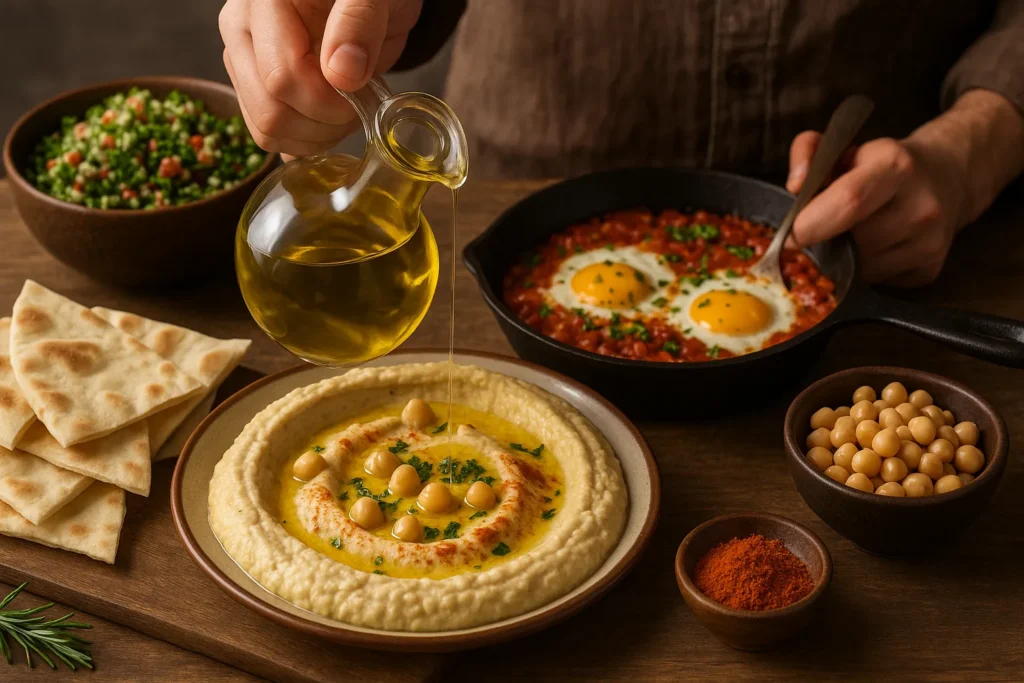
Middle Eastern cuisine uses more olive oil than any other regional cooking style. It’s not just about tradition. It’s because nothing else brings out flavor quite like it.
Olive oil shows up in every part of a Middle Eastern meal. It’s stirred into lentil soups, brushed over fresh flatbreads, and poured generously over dips like hummus and baba ghanoush. These dishes don’t just use olive oil. They rely on it.
A cooking base that builds flavor
When you sauté garlic or onions in olive oil, you create a rich base that sets the tone for the rest of the dish. That depth of flavor comes from the oil’s natural antioxidants and its ability to bind with other ingredients. Olive oil is often used at the beginning of a dish to help spices bloom and create a strong, aromatic foundation.
A finishing touch that matters
Beyond cooking, olive oil is used to finish meals and enhance both taste and texture. Whether drizzled over roasted vegetables or mixed into fresh tomato salads, it helps carry the flavor of herbs and spices without overpowering them.
In many households, a good bottle of olive oil is treated like a favorite spice. It’s always nearby and always in use.
A showcase in mezze and spreads
Staples like labneh, ful medames, and za’atar-dusted pita are never served without a pour of olive oil on top. These small plates may seem simple, but their flavor depends on using high quality oils. (If you’re curious how these dishes come together, check out this closer look at Middle Eastern cooking traditions.)
If you’ve never tried olive oil in place of butter for frying eggs, brushing flatbreads, or dressing grains, this is the moment to start. One small swap can shift the flavor of your entire meal.
Can You Deep Fry with Olive Oil? You Sure Can
Now that we’ve seen how olive oil flavors traditional dishes, let’s talk about something that still confuses a lot of home cooks: frying.
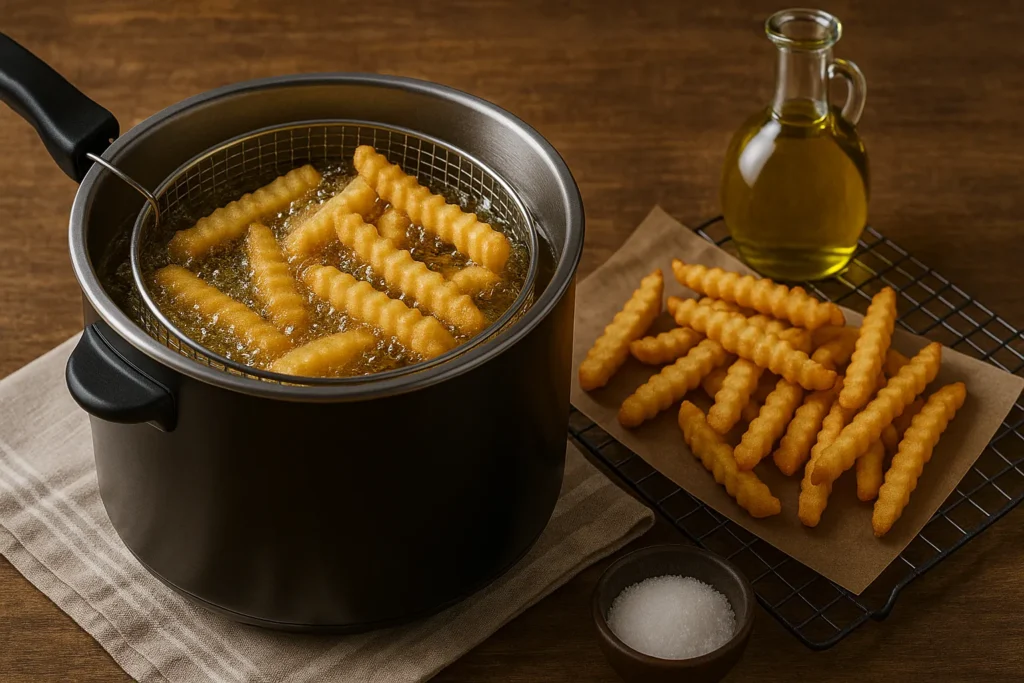
Olive oil has a smoke point between 374°F and 405°F, which makes it perfectly safe for most high-heat cooking methods, including deep frying.
You might have heard that olive oil shouldn’t be used for frying. The truth is, high-quality extra virgin olive oil holds up well in the pan. It remains stable under heat and doesn’t break down as quickly as many people assume.
Understanding the smoke point
The smoke point isn’t the only factor that matters. Stability under heat depends on the oil’s antioxidant content and fatty acid profile. Extra virgin olive oil has a high percentage of monounsaturated fats and very few polyunsaturated fats, which makes it more resistant to oxidation.
This gives it better performance than many refined oils or seed-based alternatives like sunflower oil or vegetable oil.
How Middle Eastern kitchens use it for frying
In traditional kitchens across the Middle East, olive oil is often used to fry falafel, eggplant, kibbeh, and even flatbread. When it’s fresh and not overheated, it delivers crisp texture and a clean finish without overpowering the food.
If you’re frying with butter or vegetable oil, switching to olive oil can give your dish more flavor and less heaviness.
Smart tips for frying with olive oil
- Use a thermometer to keep the oil between 350°F and 375°F
- Don’t reuse olive oil more than once for deep frying
- Store unused oil in a dark, cool place to preserve freshness
So yes, you can absolutely deep fry with olive oil. And if you’re making Middle Eastern dishes, this is often the most authentic and delicious way to do it.
How to Choose a High-Quality Olive Oil Without the Guesswork
Once you’re ready to cook and even fry with olive oil, the next step is knowing how to choose a good one.
A study by the University of California, Davis found that 69% of imported olive oil samples labeled as “extra virgin” failed to meet international standards (source).
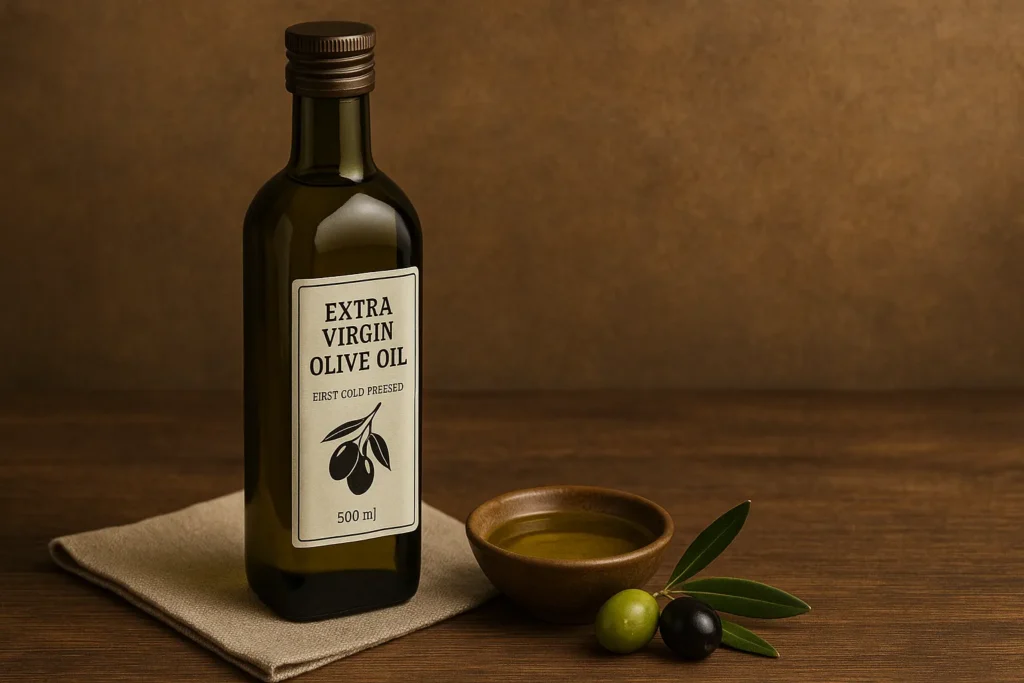
It’s no wonder so many people feel unsure standing in front of a wall of bottles. But spotting a reliable olive oil gets easier once you know what to look for.
Understand the label
Skip anything labeled “pure” or “light.” These are marketing terms for refined oils that have lost most of their nutrients and flavor. Instead, look for terms like “cold-pressed,” “first cold press,” or “unfiltered.” These usually signal that the oil was made with minimal processing, which helps preserve the antioxidants and flavor you want.
Watch the packaging
Dark glass or metal tins protect oil from light, which can degrade both its taste and nutritional quality. If a bottle looks too clear or sits in bright lighting, skip it.
You might also see harvest or “best by” dates. The fresher, the better.
Taste and trust your senses
A good extra virgin olive oil should have some bite. Slight bitterness or a peppery tickle at the back of your throat usually means more polyphenols, which is a good thing. If the flavor feels flat, greasy, or bland, the oil may be old or over-processed.
If you want to go one step further, look for oils that are certified by organizations like the California Olive Oil Council or are from trusted Mediterranean regions.
You don’t need to buy the most expensive bottle. Just choose a reliable one. A small investment here can improve your cooking and support your health every single day.
A Simple Ingredient That Brings Everything Together
Now that you know what to look for, how to cook with it, and why it matters, let’s bring it all together.
Olive oil plays a defining role in the way a dish feels and tastes, from the first sizzle in the pan to the final bite at the table.
If this sounds like something you want more of in your kitchen, now’s the perfect time to make the switch.
Choose a high-quality extra virgin olive oil, start with one or two tablespoons a day, and pay attention to how it makes your food taste. Notice how it makes you feel, too.
You don’t have to go far to learn how it all comes together on the plate. Head over to Zaytoons’ menu and inspiration page to see how olive oil helps shape authentic Middle Eastern meals, one dish at a time.
